There’s nothing like dinner with mom.
Followed by vegan cannoli from my good friend Danielle’s bakery, Vegan Treats.
Quite a lot has changed since I was vegan teenager. Always nice to slow down and reflect.
There’s nothing like dinner with mom.
Followed by vegan cannoli from my good friend Danielle’s bakery, Vegan Treats.
Quite a lot has changed since I was vegan teenager. Always nice to slow down and reflect.
Is veganism dangerous for kids? If you read the recent NY Times Op-ed you might think so. Fortunately there are experts who can point to the real science. In my first contribution for my friend Joshua Katcher’s site, The Discerning Brute, I wrote about the response from Registered Dietitians and the vegan community– and how her article isn’t necessarily a bad thing.
;
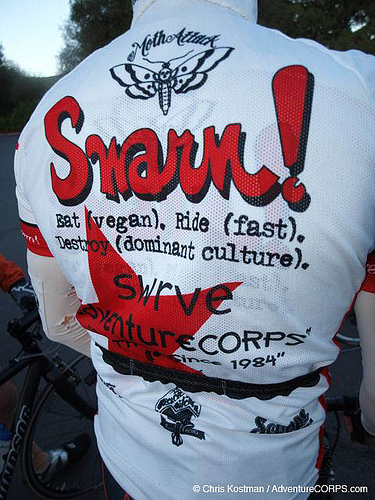
;
Last weekend I had the privilege to ride the Mt Laguna Bicycle Classic, a fantastic AdventureCORPS century in East San Diego County. I rode the pre-ride in 2009 and the 2010 event– somehow finishing in just over 6 1/2 hours. How the heck did I do that? I guess the woman at the aid station who said, ‘I thought you were fast?’ when I leisurely rolled up on the far end of the bell curve knew something I didn’t. And this was before I broke a spoke on my rear ksryium wheel and borrowed a friend’s bike to finish…
As always Chris Kostman took a million photos, most of which are available on the results page. Now it’s no secret that AdventureCORPS helps out my bike club Swarm!, as does Swarm! help at most AdventureCORPS events so what I’m going to say may seem bias. There are a few things that separate a great event from a decent event and AdventureCORPS does them all. Here’s an incomplete list off of the top of my head:
-Clear communication before the event- what the course, aid and start/finish will look like and what participants need to know and have.
-Well-stocked aid stations with friendly, knowledgeable volunteers- not just partners of participants who don’t know anything about cycling, the course or the food/supplements being offered.
-Energetic volunteers! It makes such a difference to have people out there who are stoked. Most AdventureCORPS volunteers have done the events- it makes a huge difference.
-Food at the end that isn’t the same as the snacks at aid stations. Home-made Filipino food with vegan options? Hell yeah!
-Lots of high-quality photos, clearly organized and available for free!
It was a great way to spend my day and my first century since my bike tour last summer! Geez…
This morning the Stagecoach 400 Bike Packing Race kicked off in Idylwild, CA. I really wanted to do this race. I started the motions, was mountain biking more but then just didn’t get my stuff organized. What kind of organization? See my post before I attempted the Arizona Trail Race. My DNF there really has had a huge impact on me- a year later and I haven’t even finished writing about what happened. Even though this course is much more rideable, I still had my concerns and was only willing to show up at the start if I had pre-ridden all of it. But I didn’t get it together in time. Maybe next year? Meanwhile follow the brave souls who are riding this year including Jill Homer, who I link to often, on the Track Leaders Map.
Have a great weekend and I hope Spring has sprung wherever you are and that you’re enjoying these longer days. I know I am!
Thanks to everyone who came out for the first ever Day in the Life screening. Over 70 people joined us! Many thanks to The North Face for not only providing the space, but donating 2 $50 gift cards to the raffle. Just by showing up you had a 1 in 35 chance of walking away with $50 to spend at The North Face! We’d also like to thank Veggie Grill for giving us a great deal on the delicious food and Golden Saddle Cyclery, Moth Attack Bikes and Ergon Bike Ergonomics for donating to the raffle.
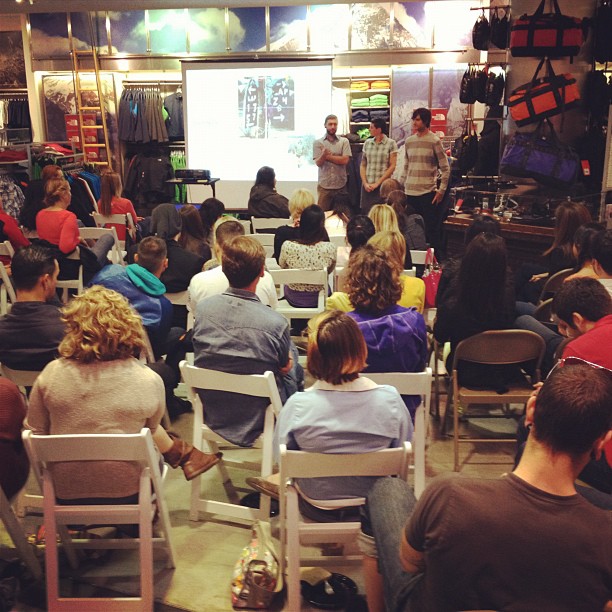
As I’ve said before, we are so fortunate to have been there to capture Donovan’s experience running 100 miles. Sasha’s short film is so damn motivating! Everyone had smiles on their faces when it ended and we had a number of great questions about veganism, ultra-running, filming and our project. The excitement in the room makes me think we need more events like this. Thank you again to everyone who came and participated in one way or another- we could not have done this without you. If you missed it and still haven’t seen it, you can always watch Day in the Life episode 5 online. Meanwhile keep your eyes out for our next episode!
Guilt is a strong emotion that plays a role in our everyday lives. It’s an emotional function that shows us the difference between our life and the life we want to live. It can lead to action, but too often I see guilt as a negative.
For example my clients tend to be ahead of the curve. They are thinking about their own diet and its effect on their health. They are eating a plant-based diet of predominantly whole grains, legumes, fresh fruits and vegetables. And they are motivated to make any needed dietary changes, but yet some are plagued by guilt.
;
Guilt-Producing Food Choices That Aren’t As Bad as You Think
Snacking. Eating snacks throughout the day increases your metabolism and keeps you from overeating at meal time. Don’t hesitate to snack on healthy foods.
Eating any form of sweetener. Yes, on average Americans eat too many added sugars and this has deleterious health affects. But are you adding a small amount of agave or maple syrup to an otherwise plant-based whole-food meal? If so, don’t sweat it.
Eating late at night. For many people, eating at night means eating additional, unneeded calories, mindlessly snacking and just making poor nutrition choices in general. But those are different than if you have to eat late because you worked late or took extra time in preparing a great meal. Evaluate what you are eating at night and if you need it, eat and don’t feel guilty!
Eating fat. General nutrition recommendations are to eat low-fat or at least less fat. But the general population is not eating a predominantly plant-based diet. If you are, then the rules are different. Plant fats behave very differently from animal fats; they can be beneficial where animal fats are problematic. Read this fantastic interview with Dr. Walter Willett for an overview of this idea. [Note that trans-fats are technically plant-based, but I’m talking about naturally occurring plant fats. Trans-fat replicate animal fats in foods and in humans]
Eating any refined grain. Yes, we should all eat predominantly whole grains. But that pizza topped with veggies and tomato sauce? Dig in. And there’s some evidence [here’s a random abstract] that compounds in whole grains interfere with nutrient absorption. This isn’t a go-ahead to get most of your calories from Chicosticks and Peanut Chews, but, as I’m saying over and over in this post, what are you eating most often? If it’s whole grains then don’t stress the occasional refined grain.
Eating processed foods. ‘Processed’ is one of those terms like ‘toxins’ or ‘cleanse’ that are so broad they have lost any real meaning- yet I hear them all of the time. So much of the food today has little resemblance to its origination and the negative health effects are well-documented. But at what point is something too processed? Fruitarians say that eating anything that kills the plant is detrimental. And I think that some textured vegetable protein products are so far from soybeans that they have lost most beneficial properties. But recently at a dinner someone tried telling me that tofu is too processed. Too processed? Check out these step-by-step instructions (with photos!) on how to make tofu at home and see that tofu maintains much of the integrity of the original bean.
Eating soy. Soy is nutritious, cheap, versatile and safe! See this exhaustive paper by superstar RD Jack Norris that cites over 130 studies.
Eating fake meats. Most of us grew up eating meat and we enjoyed the taste. Some vegetarians now abhor even the idea of meat and that’s fine; I’m not about to talk someone into eating fake meats. But for the rest of us: the occasional meat analog is quite satisfying. Should you rely on them for most meals? No, definitely not. Should you focus on whole foods like beans? Yes. Just don’t feel guilty about the times you want to dig into a nice vegan pizza topped with veggie sausage.
Some of you will read this and think about how you never do any of these and why would anyone? Congrats to you because you are definitely an exceptional person. I wouldn’t advise you to do otherwise. But for most of us the above are real-life examples of how we balance good nutrition and our desire for certain foods. My point is that the evidence in the nutrition field isn’t precise enough to say there are benefits to never doing the above. What you eat most often is what really matters. With the assumption that you are already eating a plant-based diet of predominantly whole grains, legumes, fresh fruits and vegetables. The guilt that we feel and the stress of trying to be perfect are worse for us than doing any of the above!
Can you work on feeling less guilt? I hope so! Thanks for reading and I hope this is helpful. Have a great weekend and maybe I’ll see you Sunday night at our Day in the Life screening?
I am so stoked to announce our first ever Day in the Life screening! On Sunday April 15th at 630pm at The North Face in Beverly Hills [map] we’re showing a special edition of Donovan’s episode where he runs his first 100-mile race. A Q&A with Filmmaker and co-creator Sasha Perry, ultra-runner Donovan Jenkins and myself will follow.
-Free food samples from The Veggie Grill! Both The North Face and Veggie Grill have been super helpful in making this event not only great, but free. These will be samples, not a meal. Looking at you Jack Lindquist.
-Raffle for all attendees! Prizes from Golden Saddle Cyclery, The Farmhouse Conf 2, The North Face and True Love Health.
-It’s the night of CicLAvia, which you should definitely also do that day.
-The Q&A should be super fun because we’ve planted people to ask all the pressing questions like, ‘where do you get your protein?’
Share the above flier and the link to this page with running and vegan forums, meet-up groups, organizations, etc. Your own connections can really help to get people there!
Use this printable pdf of the flier for running stores, vegan restaurants and other places.
Join and share the facebook event page.
Thanks for reading and I hope to see you there! If this is a success there’s talk of a mini-tour where the three of us travel to do screenings in other cities.
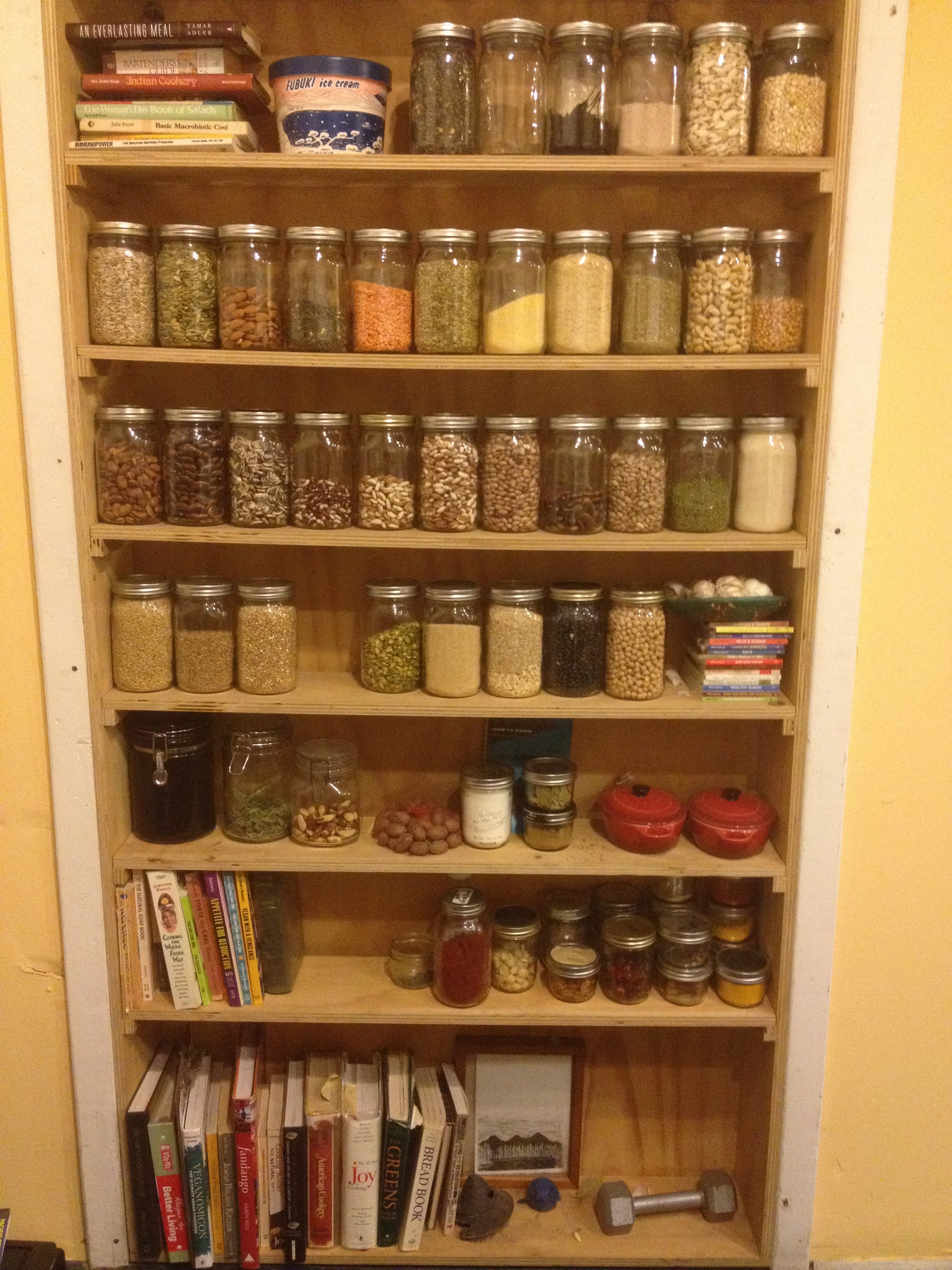
My good friend Lisa, whom I have mentioned regarding her Tract House project and Bike Night at the Hammer (2009, 2010, 2011) lives in a warehouse in downtown LA with a few other artists. I was heading over there the other day because Morgan and Mike Szerszunowicz‘s band was playing and Lisa asked if I wanted to come by earlier for dinner. Of course! She was making pasta with beans and kale, but I didn’t recognize the bean and when I asked she showed me this bag:
Tepary beans are pre-Columbian and native to southwest US/Mexico and traditionally are used in the Three Sisters farming method. They are highly drought-resistant and the flavor is almost nutty. They were delicious with pasta and kale. According to this article 24% of the calories are from protein which puts them above almost all other legumes! They are also high in fiber and iron. The ones she uses are available here.

Now Morgan is no slouch in the kitchen either- like when he made curry after our mountain run– and even though his band was playing, he took the time to make relevant pesto. Yes, relevant pestos! Their band is Yersinia Pestis, named after the bacterium that caused the major plagues in early European times. So why not spicy pesto to accompany black metal?

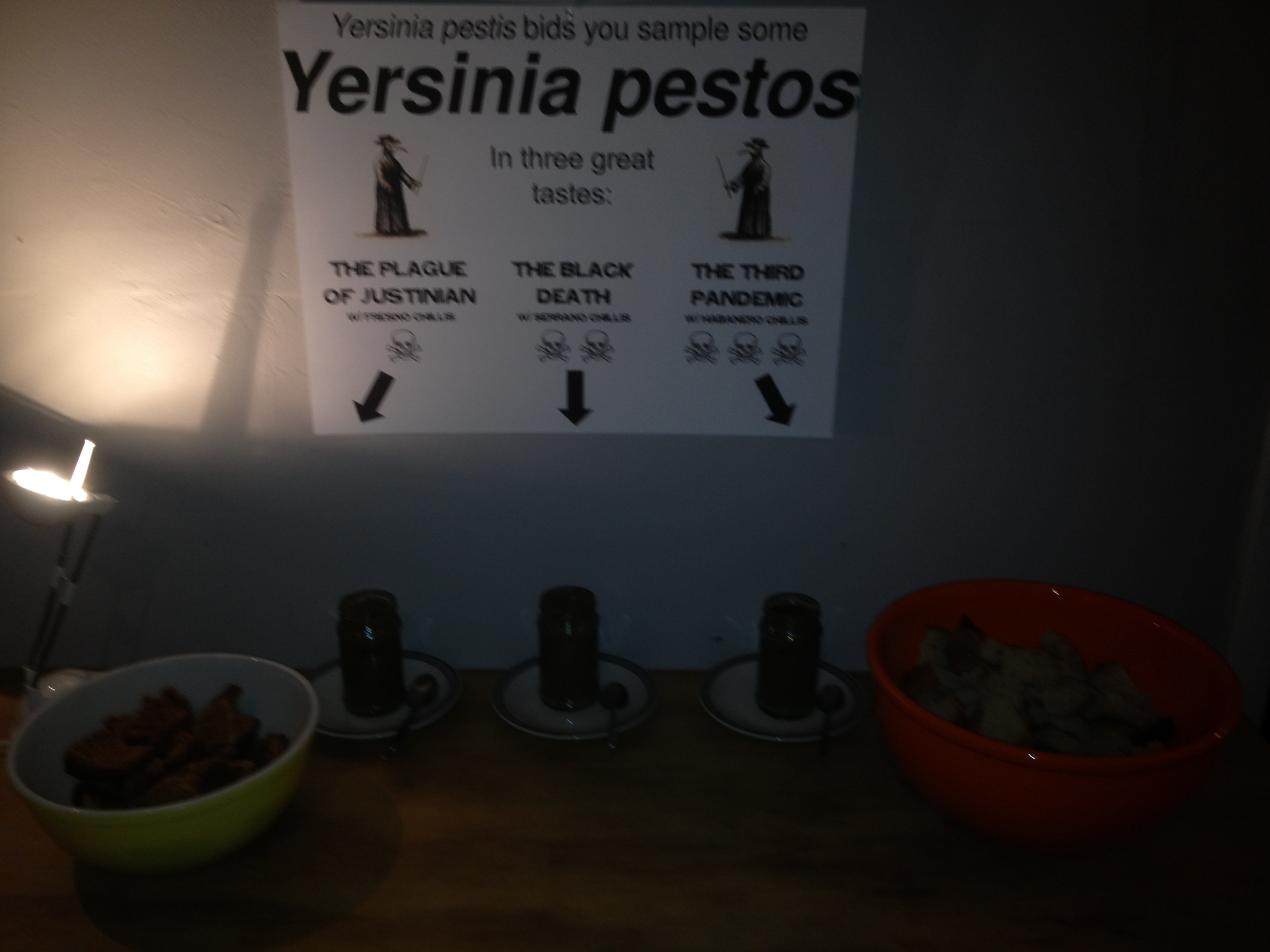
I asked him about the recipe and sure enough the base is the Classic Pesto from Vegan with a Vengeance which we made regularly when we lived together. It’s super good! Here is a video of it being prepared (with recipe) and it is also very close to this Post Punk Kitchen version. Like Isa says, pesto is delicious, versatile, easy to prepare and a crowd-pleaser. I highly recommend making this recipe. Level of death spice up to you!

This post took a turn toward the macabre with all this talk of plague and bacteria, but don’t let that keep you from making great pesto or integrating fun food into your life!
Photo from my bike club’s tumblr of an early round of pizza making
Oh, pizza how I love you. I won’t pretend that pizza is a health food, but I do know that it has been an integral, yummy part of my diet since I was old enough to think about food. In my Italian-American household growing up pizza was a ritual. My father painstakingly searched out all the local pizzerias to find one that made pizza closest to what he grew up with in Brooklyn. He practically interviewed the owner and the pizza maker (often the same person). I remember this place opened by a family who had moved from Brooklyn gave my father a special gold discount card because they loved how much he loved pizza!

But then pizza became an issue when I first went vegetarian at age 13. I would pick the pepperoni off my slices and my father would yell at me that I was wasting money and we couldn’t afford to not eat toppings. When I went vegan a few years later my generally supportive mother was concerned that I was depriving myself unnecessarily by excluding cheese. “But, why cheese too? What will you eat, how will you survive?”
For years I ate cheeseless pizzas or made my own with pre-made dough and was generally happy with them. When vegan cheeses improved in the early aughts, I still wasn’t that impressed. I’d much rather have a tasty cheeseless pizza than have a mediocre cheese on there. But, and I hate to admit this, when Daiya came out it really was a game changer. All this time and I had never made my own dough. The rising and the kneading, it always seemed more science than art, and that’s not my cooking style. But then one day I wanted to make pizza with a friend and there were no pre-made doughs at any walkable stores. We had to resort to buying pre-made crust. It was expensive and incredibly meh. That did it!
So with new found excitement I called my good friend Dave Vandermaas (photo) who I knew would have a kick-ass dough recipe. Then I decided I wanted to make deep dish pizza in cast-iron skillets. It’s on another level! And it’s so much easier than I ever thought it would be. I’ve played with the recipe and made some small changes- maybe pizza making is more art than science!
Perfect Pizza Dough
1 package dry yeast
1 cup warm (not hot!) water
2 1/4 cup flour
1 1/2 T olive oil
1 t salt
2 t sugar
1. Add dry yeast and 1 t sugar to warm water, let stand for 10 minutes.

2. Meanwhile combine flour, salt, remaining sugar and olive oil in a medium-sized mixing bowl.
3. After 10 minutes and yeast has grown significantly, add to mixing bowl.
4. Stir ingredients until well-combined. Dough should be slightly wet- it’ll stick to your fingers.

5. Cover with dish towel and let sit in a warm place for 30 minutes- I turn my oven on at 100 degrees and then turn off immediately. Racks should be warm to touch but not too hot.
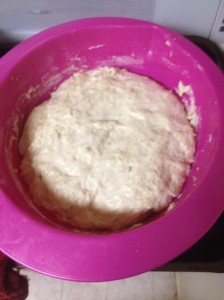
6. Dough should have risen to about double its size. Lightly flour a flat surface and your hands, pull dough out and kneed to shape. I flatten and double at least twice, but spend only about 2 minutes doing this. It’s way easier than I thought!

7. Flatten dough into cast-iron, add toppings. Traditional deep dish has sauce on top of cheese, but I still prefer my cheese in between the sauce and toppings.
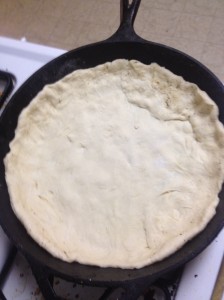
8. Bake at 400 degrees for about 20 minutes.
Note- I always double the recipe and use 1.5 doughs for my 12-inch cast-iron and 0.5 doughs for the 9-inch one.
Toppings for two pizzas
1 small head of broccoli finely diced
1 zucchini finely diced
4 cloves of diced garlic
1 bag Daiya mozzerella
1/2 package Field Roast sausage
15 ounce jar pizza sauce (slightly thicker than marinara)
Cost- These two pizzas cost me about $13- and I used organic flour, yeast, vegetables and pizza sauce. And half of that cost is the vegan cheese and sausage!! So you can make two organic cheeseless veggie pizzas for about $7 with pretty minimal effort. How amazing is that? And if you are like me and more of a cook than a baker, don’t let pizza dough intimidate you. It’s not a perfect science and if you are comfortable in the kitchen you too can make these fantastic pizzas.
Let me know if you try them! And please do share any pizza making tips and recipes in the comments. Thanks and enjoy!
I eat giant salads:
For most people salad consists of a pittance of iceberg lettuce, gross tomatoes and a few uninspired cucumber slices. Boring and far from a meal. Heck, I was one of those people still many years after I went vegan. I’m not sure what changed, as it has been gradual and painless- enjoyable even- but somewhere along the way my ideas progressed.
And I have to remember this in my work. When I say ‘salad’ what I picture and what others picture can be drastically different.
No, no, don’t worry I’m not becoming raw! But I recently did 5 days of mostly raw and really learned a lot about raw food diets. Usually when I do a raw-ish few days it ends up very fruitarian-
Breakfast- bananas, apples, nut butter
Lunch- carrot/apple/ginger juice
Snacks- other fruits, kiwi are my favorite when I can find California-grown
Dinner- a gigantic salad with green leaf lettuce, cucumbers, tomatoes, bell peppers, avocado, carrots, walnuts, nutritional yeast and flax oil.
For a few days this is great, but I get bored pretty easily. Maybe it’s the equivalent of the pasta/marinara sauce vegan diet?
This time I wanted to expand my knowledge and experience with preparing raw foods and really challenge myself. It’s also healthy to get out of your own eating pattern to look at the habits you have developed. To anyone who says going vegan is easy, I challenge you to do 5 days raw! There was more than one occasion where I was standing in the local co-op, starving because I hadn’t prepared well, and the smell of vegan mac and cheese was killing me! After an internal debate about why in the world I was keeping myself from such deliciousness, which probably looked hilarious to on-lookers, I went with a seaweed salad and a raw garlic spread on collard greens. This is the dilemma that faces anyone making lifestyle changes and if you are someone who encourages behavior change you have to check yourself occasionally to remember what it’s like.
Also, during this time I finally sat down and read Becoming Raw, the terrific book written by super-star vegan Registered Dietitians Brenda Davis and Vesanto Melina. I picked it up from Book Publishing Co., who are also friends of mine, back at a nutrition conference in the fall.
I’ve been getting asked about raw food diets a lot lately and I’ve never been content with what I’ve read and the knowledge I have ascertained until I read this book. The authors painstakingly reference any research they could find related to raw food diets and discuss it using their expertise as Registered Dietitians and long-time vegans. I think true objectivity is impossible, despite what anyone says, but Davis and Melina are as close as possible. They include a history of raw-food theory written by Rynn Berry and explain contemporary versions of the diet; which is very helpful for anyone working with raw food clients.
My own professional opinion on raw foodism has always been pretty simple. It is an adequate diet where one can get all the nutrients they need (If B-12 is supplemented) and all of those fruits, vegetables, nuts and seeds provide phytochemicals and anti-oxidants in huge quantity, which is health-promoting and chronic disease fighting. But I don’t think there’s enough research to say that it is any better than a whole-foods based cooked vegan diet. I just don’t think foods like lentils and quinoa need to be eliminated. There are plenty of philosophical and environmental reasons to eat raw and I agree with them, which is why I include a plethora of raw food in my diet, but I’m just not convinced that being fully raw is different enough to justify limiting so many vegan options. Though I’ll continue to read the research and advise all of my clients to eat more raw food and to read Becoming Raw.
The authors were kind enough to let me post two recipes from their book. I made this Brilliant Broccoli salad on my first day raw and loved it so much I made it again the next day! The sum is greater than the parts where the tanginess of the lemon and cranberries are a perfect compliment to the strong taste of tahini- and broccoli florets are the perfect vehicle.
1 bunch broccoli
2 carrots, grated
1/2 small red onion, finely diced (I used about 1/4)
1/2 cup dried cranberries
1/4 sunflower seeds
Salt
3/4 cup Lemon-Tahini Dressing (recipe below)
Wash broccoli, remove stems. Peel and grate the stems and chop the broccoli tops into very small florets. Combine stems, florets, grated carrots, diced onion into bowl. Add dressing and stir well to coat the vegetables. Season with salt to taste. Add cranberries and sunflower seeds and toss briefly. Serve immediately!
1/2 cup water
1/3 cup freshly squeezed lemon juice
1/3 cup tahini
1/4 cup flaxseed oil (I used a little less)
3 T nama shoyu or tamari
2 T nutritional yeast
2 T maple syrup or other sweetener
2 garlic cloves
Salt
Ground black pepper
Combine in blender and and process on high speed for a few seconds until well blended. Makes about two salads worth.
This recipe for raw walnut tacos is not from Becoming Raw, but it was another meal I really enjoyed. I first experienced it when Brian Davidson and his wife Jenny made it for me back when he was fully raw. There are a number of raw walnut taco recipes on the internet and they all are basically a variation of the one below. Now you aren’t going to fool a carne-asada loving omnivore, but the similarity to tacos is striking. I love these!
1 1/2 C walnuts (some suggest soaking them in water briefly beforehand)
1.5 t ground cumin
1 t ground coriander
2 t nama shoyu, tamari or soy sauce
cayenne to taste
Ground walnuts in a blender or food processor until you have very small pieces. Place walnuts in a bowl and mix in remaining ingredients. Serve with tomatoes and avocados in lettuce or kale leaves.
What are your favorite raw vegan recipes? Please share them with me! And I really do recommend that all vegans do a raw food challenge and learn more about preparing and eating raw foods. Have a great weekend!
The main goal of our Day in the Life series is to show the world that vegan athletes exist and thrive on their diet and lifestyle. But as we make more episodes a second goal is developing: what crazy situations can we can put Matt in?! Today we spend the day cyclocross training in the snow and cold with bad-ass cyclist Cat Johnson in Boulder, Colorado.
How great is Cat?? I love her comment, ‘I went vegan for the cause!’ Veganism and bike racing: There are many ways to do it and you have to look around and see what fits your personality. Don’t rely on any one way to do either. Cyclocross is the most inclusive form of competitive cycling and in my opinion the most fun!
-No one in cyclocross cares how well you are doing as long as you are having fun. Like when she says, ‘No one cares if you are last’ and there I am, in last place in our training ride!
-There are beginner categories that are truly are beginner and inclusive.
-The courses are loops which makes it very spectator friendly. Bring your friends and fam to cheer you on!
-It’s a mix of skills- speed, bike handling, running, jumping- and this evens out the field.
-You can use almost any type of bike that can run fat tires. And many races rent cyclocross bikes!
-There are single-speed categories and even Single Speed World Championships!
-Some resources: Cycling Dirt, Cyclocross Magazine, the super fun SoCal Prestige Series in Southern California, and a Beginner’s Guide to Cyclocross on Active.com.
-Like Cat says about veganism, you can look to different people for different motivation and figure out which type of riding is best for you.
Your post-workout meal should be easily digestible, high in carbohydrate with some protein and be consumed shortly after your workout. This not only replaces the glycogen you expended, but helps to increase your glycogen storage– giving you more energy for your next workout. And even though protein builds strong muscles, those muscles are fueled by carbohydrate.
1.5 cups non-dairy milk like almond, rice or hemp (Hemp milk is higher in protein than other non-dairy, non-soy milk)
1/2 cup of frozen blueberries
1/2 cup frozen peaches
1 scoop Vega Performance Protein powder
What’s great about smoothies is how flexible they are! Remember our meal-replacing, peanut butter and banana smoothie with Brian from episode one? Cat’s smoothie is similar in that you can easily adjust the calorie ratios. The protein content can be adjusted by switching non-dairy milks and how much protein powder you add, or don’t add! For example I use a higher protein milk and don’t use protein powders. And for Omega-3 I use straight flax oil.
Cat would like to thank her coach Colby Pearce, who took us out on the training ride, her current sponsor Panache Cyclewear and her previous sponsors The Service Course and World Bicycle Relief. And thank you Cat for spending your day with us!
What’s your favorite recovery meal or smoothie? And if you have any cyclocross resources that I didn’t mention please leave them in the comments!